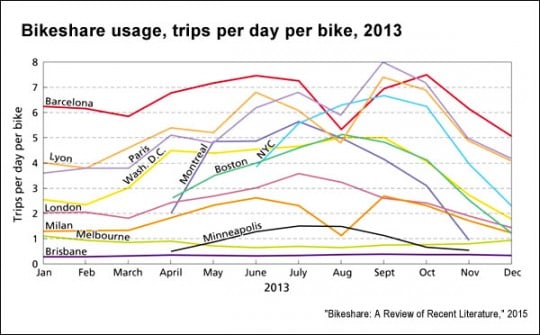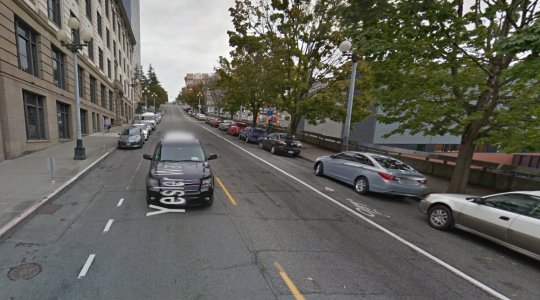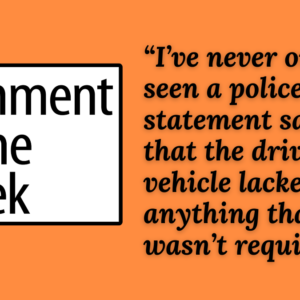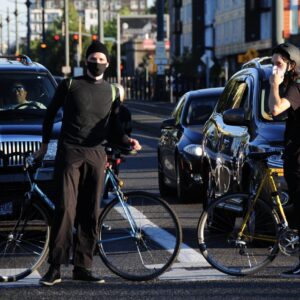
(Photo: Diane Yee)
As we mentioned in this week’s news roundup, Seattle’s 16-month-old bike sharing system is in a very tight spot.
With the Pronto system taking in only 68 percent of the money required to meet its operating costs last year and the city considering taking it over in order to bail it out, many Portlanders are rightly wondering whether the upcoming Biketown system (which will be operated by the same company, Motivate) could face similar problems.
We talked to some of the country’s leading independent bike-share experts today to get their take. Here’s what we heard.
Seattle’s #1 problem is low ridership per bike
 (Via JournalistsResource.org)
(Via JournalistsResource.org)
This is maybe the single most important number for all vehicle-sharing systems.
“You get your really high-performing systems like New York or Chicago that have like five trips per day,” said Phil Goff, a Boston-based senior associate for Alta Planning + Design who specializes in bike sharing feasibility studies. “And then there are some pretty high performing systems in the 2 to 3 range like Salt Lake City or Boston.”
Seattle averaged only 0.8 rides per bike in its first year.
“It sounds like the ridership projections were off, which happens,” said Paul DeMaio, a bike sharing consultant with Virginia-based Metrobike LLC. “If revenues are off, as it sounds like they were, then obviously it impacts the sustainability of the business.”
If Seattle had anticipated ridership that low, it wouldn’t necessarily be a problem.
“It’s not microscopically low,” said Goff. “There are other cities that are roughly within the one trip per day per bike range.” He mentioned Chattanooga, Tennessee, and Columbus, Ohio.
But Seattle, where biking in general is certainly more popular than in Chattanooga or Columbus (as well as Salt Lake City, Boston, New York and Chicago, for that matter), did anticipate higher ridership. Which is why…
Pronto launched with a bunch of loans
This is the first major difference between Seattle’s system and Portland’s. Alaska Airlines put up a lead sponsorship worth $1,000 per bike per year for 2014 through 2019 — $2.5 million total — but that and the city’s public start-up funds didn’t turn out to be enough to launch the system.
So the nonprofit that manages Pronto, Puget Sound Bike Share, took out loans to cover the difference. Last year, debt payments added up to almost $300,000, 15 percent of the system’s operating costs. Next year they’re on track to hit $500,000, according to a presentation being prepared for Seattle’s city council meeting Tuesday.
Biketown is starting from a much healthier place. Portland’s $10 million title sponsorship from Nike is four times the value of Seattle’s sponsorship — $2,000 per bike per year after accounting for the fact that Portland will launch with 1,000 bikes rather than Seattle’s 500.
Moreover, Biketown’s up-front costs per bike will be lower than Seattle’s because its “smart bike” system (which puts the computer on the bike rather than in the kiosk) saves a lot of money on station purchasing and installation.
Seattle has three major ridership challenges compared to other U.S. systems

(Image: Google Street View)
Here they are, probably in descending order of importance:
1) Huge hills in the middle of the service area
2) A system with two hubs instead of one
3) A mandatory helmet law
Portland faces none of these challenges.
Our inclines (for example, the climbs to Portland State University or the Mississippi District) aren’t nothing, but they’re not much compared to First Hill or Capitol Hill. Knowing this, Pronto launched with seven gears on its bikes instead of the usual three. I don’t know about you, but that’s definitely not enough to get me pedaling up Yesler on a 50-pound bike.
Another Seattle issue: the decision to put 11 of its 54 stations in the University of Washington area. A study last year concluded that station density per square mile is essential to maximizing bike share ridership. Seattle’s system spread itself thinly over five square miles rather than concentrating on a single area.
Advertisement
Spreading itself thinly is certainly a risk for Portland; it first planned an eight-square-mile service area for 600 bikes (thinner than Seattle, that is) and now plans a somewhat larger service area for 1,000 bikes. But unlike Seattle, Portland isn’t likely to have two distant hubs; instead, it’ll probably concentrate stations in the downtown and gradually get less dense further out.
The last item is the most interesting, so let’s devote a whole subhed to it.
Helmet laws probably hurt bike sharing
Seattle, which was home to an influential 1989 study of bike helmets that has never been replicated and was repudiated by the federal government in 2013, is one of the few cities in the world where helmets are required for all adult bike users.
Though Seattle’s helmet law isn’t heavily enforced, it’s had several effects. First, it’s obligated cash-strapped Pronto to spend about $80,000 a year offering helmets to its users. Second, it makes people who choose to rent a helmet (for $2 a pop) go through the time-consuming step of finding a properly sized one and adjusting its straps properly. Third, it propagates the idea that bike sharing (which has yet to be associated with a single fatality anywhere in the United States and actually tends to reduce biking injuries in cities where it operates) is dangerous.
Aside from Seattle (and Vancouver BC, which doesn’t yet have a bike share system but is expecting to launch one) the main home of adult bike-helmet laws is Australia. And, lo and behold, that country’s two bike-sharing systems also perform woefully, with half the per-bike ridership of Pronto.
Because of all these differences between Portland and Seattle, Goff (who certainly has a financial interest in bike sharing’s success, but not in Pronto in particular) said it doesn’t make sense to assume Biketown will have problems just because Pronto is.
“I hope there aren’t people in Portland saying, well, it’s not working so well in Seattle, it might not work down here,” he said.
There might be a silver lining in Seattle’s cloud

(Photo: Seattle DOT)
We’ve been rough in this post on Seattle, which is also a city doing a lot of things right. So let’s close on a contrarian note: despite the costs, this might actually turn out to be terrific for Seattle.
Here’s the basic problem with North American bike sharing: Almost all cities have been holding it to some of the standards of public transit — pushing for it to be used by people of all incomes and races, for example — but not giving it the public subsidies that virtually every U.S. public transit system would collapse without.
It’s entirely appropriate to hold a public system to a high standard. But equity goals cost money. And if Seattle’s city council votes tomorrow to subsidize Pronto by buying it out and then follows up with the massive expansion it’s already proposed, that could put Seattle on track to become the first U.S. city that actually uses public money to create a truly great bike share system.
That’s DeMaio’s interesting take.
“Some folks look at it as a takeover, as I think I’ve heard,” the Virginia-based consultant said. “However, this is very similar to what happened in many cities around the country, including in New York, with the private sector starting up subway lines and the lines not being profitable. So in the end the public sector stepped in, combined the lines, made them easier to use, expanded the service and brought back the customers.”
Could that happen? Should it? As always, we’ll be watching.
— Michael Andersen, (503) 333-7824 – michael@bikeportland.org
BikePortland can’t survive without paid subscribers. Please sign up today.






Thanks for reading.
BikePortland has served this community with independent community journalism since 2005. We rely on subscriptions from readers like you to survive. Your financial support is vital in keeping this valuable resource alive and well.
Please subscribe today to strengthen and expand our work.
This Seattle Times column makes the case that one of the problems is Seattle’s lack of a good bike network in downtown. The editor of Seattle Bike Blog is quoted as saying “if you’re considering trying out a Pronto bike, but you know you have to go elbow to elbow with cars on Fifth Avenue, are you going to try that?”.
We have the same problem in Portland. When Biketown launches there won’t be a single northbound bike lane (protected or otherwise) through Downtown, and likely wont be for another couple years. That will make for some pretty intimidating journeys for casual riders.
What’s the status on the Downtown Multimodal Project? Would be great to have that buildout coincide with the launch of BIKETOWN.
As we reported on 1/8, those new bikeways very likely won’t be on the ground until 2017. http://bikeportland.org/2016/01/08/bike-share-deal-ups-the-pressure-for-downtown-bikeway-project-172065
The good news is that all those new Biketown riders will put a lot of pressure on the downtown business community to support great bike facilities.
We have a lot to learn from other cities. I’m disappointed that Taipei’s Youbike isn’t on the graph above. It’s a huge, heavily used system that has really enhanced my life since moving here from Portland. The stations cover the entire city and I ride it most days for about US$.60. Maybe it’s the language barrier, but I had never heard about it until coming here. I hope we can look beyond Europe, North America, and Australia. Some of the world’s best bike cities are in Asia.
Can you find a better data source? I’d be great to see more than 2013 also.
I agree. No, I couldn’t easily find a more comprehensive data source.
Low ridership certainly makes it difficult to financially sustain a bike share system. But I think it is also important to look beyond maximizing ridership when siting for bike share stations. Bike share can be a great investment for the first/last mile issue and improve people’s access to transit.
As Michael’s Friday post pointed out, low income workers who need to travel great distance to get to their jobs rely mostly on transit rather than bikes. Of course, increasing transit frequency and geographic coverage would help people with constraint transportation choices the most, but bike share can also improve their access to transit. It makes sense from a ridership point of view to concentrate bike share stations in Downtown Portland, but perhaps the City can also think about where there higher “needs” when determining station locations.
An article from the Seattle Bike Blog last Friday makes a similar point.
There’s a counterpoint to this, which goes basically like this: if the object is social justice, there are more obvious ways to approach it than bike-share.
A system that doesn’t get used much is, by definition, not providing much of a public benefit. You can build suburban satellites around regional transit and employment nodes; the Bay Area tried this, with much larger and more diverse suburbs than the PNW has, and it flopped. Citi Bike-style bike share requires a lot of initial investment and has high enough maintenance and operation costs that at least moderate ridership is needed — not just to support it financially, but to justify such an investment compared to other approaches (like those Lugo suggests in her article). Rather than take bike-share and try to fit it to a social justice problem, better to seek social justice in the most effective way possible.
The best intentions in the world won’t pay your rent.
Does it help that Seattle and Washington are trying to build an underground freeway that costs in the billions of dollars?
It sure would be interesting to see Seattle repeal their mandatory helmet law now that they have a baseline for what ridership looks like with it. Then we could really see what the impact of helmet laws on bikeshare systems is.
It’s a king county law. They need to be creative.
The sad thing is the service area has the highest studio rents. 1400 on up with utilities.
Hopefully they will expand.
I assume this question has already be asked, but: How do bikeshare programs determine how many of their users just shifted their mode from public transit to a bike? If they don’t capture this statistic, there is no valid way to judge the success, or failure, or the program.
A lot of systems have directly asked this of their users. You can explore what Minneapolis users said in this post:
http://bikeportland.org/2015/09/10/ok-exactly-bike-sharing-survey-explains-well-158650
The important underlying question, though, is what the purpose of bike sharing is.
– If it substitutes for trips that would have happened on mass transit (which it frequently does), then it is making the public transit experience and/or the general car-free transport experience better. Maybe this is the purpose.
– If it gets people who used to never ride bikes to occasionally ride bikes (which it does), then it makes us all more sympathetic to people who ride bikes, which makes the streets safer. Maybe this is the purpose.
– If it gets people who used to never ride bikes to experiment with bikes and then use their private bikes more (which it does) then it increases bike use gradually over time. Maybe this is the purpose.
Here on bikeportland and elsewhere, I’ve read comments from people suggesting they do, or will use bike share for home to work commuting, or middle of the workday lunch breaks or errand running. How much of that type riding will happen in Portland is something I’d have difficulty venturing an idea about.
Tourist use of bike share: some of the people staying at the hotels on the waterfront, might like riding the bikes across the river and over to the Springville corridor trail out and back. Imagine how the ‘houseless’ people might enjoy say, if it somehow were to happen, a tenfold increase in the number of people riding past their campsites.
Or, tourists might like riding the loop made by the east and west side waterfront esplanades, as if that loop isn’t already kind of overwhelmed at times. I can see that a lot of people might like to do this loop by bike, just because it’s not that long, might be easier and faster than walking, and it lets people see both sides of the river from a lot of different angles as they dawdle along, relaxing.
For people wanting to use the bikes to get a true physical workout, that could be interesting, probably way more challenging because of traffic and lack of provision for biking on the streets there than most people would want to deal with. Portland has some serious climbs surrounding the west side of Downtown. Up Terwilliger, Vista Ave or Broadway Drive. Riding a bike share style bike up any of those hills would definitely be a workout.
Those are all pretty low standards of success for a $10 million project. I would think that success would be measured by bike sharing resulting in fewer people driving cars, taking taxis, etc., not nebulous ‘gee that was fun’ reactions.
Improving public transit is a low standard of success?
In any case, this isn’t a $10 million project. It’s a $2 million public project (so, two miles of sidewalks, or eight stoplights) that has so far drawn another $10 million in private financing from Nike and will get millions more from the users themselves. This is the argument for bike sharing: the public cost is really small compared to the benefits.
I wouldn’t use former transit ridership as a criteria for success or failure of a bike share program.
And yet, many transit agencies have problems with overcrowding during peak commute hours, yet lack the resources to add service at that time. Bikes can do an excellent job of “shaving the tops off” of that crush loading. Many agencies understand the value of this. Therefore I think that shifting trips off transit, at least in peak hours, could be success, at least if it frees up seats for people who are not able to use bicycles.
From someone that has both ridden and driven the hills in Seattle. As a cyclist, there is no way I would be riding the streets of Seattle without a helmet. Most of the easy hills are in the catagory of NW 23rd coming down or going up between Burnside and Salmon. There are a lot of steeper ones. I have also endoed on those hills avoiding cars. I would have been dead within a week without a helmet.
Aren’t we being a tad bit melodramatic?
You can easily ride down those hills slowly and in control. I lived there many years ago and rode those hills in the U District a lot and never felt unsafe without a helmet. The street I lived on was insanely steep too.
The timing of the launch (October) also didn’t help. The hills have a silver lining to them though: I wouldn’t ever ride one of those beasts up to Capitol Hill, but there is no faster way to get back downtown.
The absurdity of not placing and stations along the Burke-Gilman is tragic.
I commute 26 miles a day, ride 5000 miles a year and I hate riding in downtown Portland….
This has Fail all over it in this bike city USA.
Sit on the Broadway Bridge during commuter hours, or near Williams, or on the Hawthorne Bridge, and you’ll find there are plenty of people who disagree.
you’ll also see the many people that agree and didn’t bike…
Bike helmet laws are oppressive and essentially are designed to cut bike use.
jaywalking laws create drivers…
Nice to see the situation explained. The difference in funding should really help- if nothing else, we have 5 years to get things together.
I forgot about the nutty helmet law problem, but the UW and Cap Hill problems were what I immediately thought of.
Let me fix that: the public subsidies that every U.S. road system would collapse without.
That too.
It would be really interesting to calculate and map the actual costs per mile if there were no federal, state or local tax subsidies. You’d need realistic build/maintenance costs as well as traffic density by vehicle type data for each stretch of road, as well as some notion of the wear inflicted for each trip by vehicle type. And probably a bunch of other data I’m not smart enough to think up. I wonder if we even have the data necessary to do this sort of analysis.
The cost would be infinite, or nearly so. Where would the roads come from, without some sort of governmental “subsidy”?
My question is not directed at removing the subsidies but understanding them.
The thing that’s most disappointing about Pronto is how fast it’s gone under. There’s some potential for ridership growth within the Pronto service area as new buildings (especially in SLU and northern parts of downtown) fill in and major public works projects finish (especially near Highway 99), but that’s all a few years off yet. Planning a 2014 launch in Seattle without the resources to weather a few tough years was planning to fail, as a few tough years were totally predictable. Maybe they just should have waited…
It’s not just Pronto. Seattle’s streetcar and Link Light rail have absurdly low usage compared to Portland. I think the wealth gap and mentality up north has a lot to do with it… wealthy people are more likely to drive fancy cars rather than take a train or bike.
Seattle has a bad habit of building everything in segments. The streetcar and Light rail are not an apples to apples comparison to anything in Portland. The Street Car line is nothing more than a toy at the moment and they just opened a new line last weekend, which will help. Once the 2 lines connect, it will be successful. I do have to disagree with you about the light rail. The one line is doing incredible and growing every month and will be expanding to 2 new stations next month. In any case, Seattle is a city that should have one of the best public transit and bike networks in the country but they are too afraid to build everything at once.
And I think you are pretty off about the “northern” part of Seattle being too uppity to take alternative transit. There is no light rail to anything north of downtown. The other large impediment is the Ballard Bridge. Nearly all of the city’s growth is going towards that neighborhood but you have to take your life in your hands to cross the bridge and then the “missing link” of the Burke gilman trail is still tied up in court. Seattle could nearly double it’s bike commuters if they just improved the bike connections in that neighborhood. It has nothing to do with people being wealthy. Last time I looked, Seattle as a whole had a higher rate of public transit than Portland despite our lackluster infrastructure…
I lived in Seattle’s north side for about half the time I was there. The buses I rode were jam packed every day. And the north end always voted overwhelmingly (3:1 or better) in favor of transit projects – it took so many years to get light rail going there because the suburbs dragged their heels so badly. I’d say Seattle’s suburbs are worse than Portland’s in terms of people being anti-transit, but that does not apply to North Seattle.
Relating in this story to mandatory helmet use laws, relative to theories about their effect on bike share:
“…Third, it propagates the idea that bike sharing (which has yet to be associated with a single fatality anywhere in the United States and actually tends to reduce biking injuries in cities where it operates) is dangerous. …” bikeportland
Is it not the motor vehicle traffic people often find themselves riding in, that may be leading people to feel that this traffic creates dangerous conditions for riding a bike? And that their use of a bike helmet may offer them some help in the event they happen to fall because of that traffic?
Large areas of Washington, including the city of Seattle, implemented an all ages mandatory bike helmet use law. In those areas, from residents, I wonder how much support there might be for a suggestion to either temporarily waive enforcement of the law, so to suspend enforcement indefinitely. Or, in Seattle exclusively as an effort that may possibly entice more people to use the city’s bike share bikes.
That’s not what the experts I talked to today think the effect of helmet laws is, but it’s a fair theory.
How many people were already riding 50lb 7-speed upright bikes there? Maybe a lift up the hill would help. A schlumpf drive could give another 40% reduction, but a motor might cost as much. The battery maintenance though…
The helmet issue could be fixed by requiring pedestrians and drivers to wear them too. Wherever you go, there you are wearing a helmet. So safe, except for that thing about taking risks.
Why do we always take governments estimates as truth. I don’t think they’ve ever hit the mark on anything. The arts tax missed the mark, the 1%er income tax at state level missed the mark. I don’t have any expectation that government estimates on this will be any better.
It would be interesting to see some thoughts from “experts” who don’t stand to gain from their findings. I don’t doubt these guys know a great deal about bike sharing, but there is certainly room to question their objectivity.
I was in Seattle a few months ago, and was tempted to try out a bike. I was deterred by the relatively high cost to get a bike as a non-member. ($8 for a day, if I recall, plus a rapidly increasing rate if I kept the bike longer than 30 mins; I think I calculated a 2 hr ride to be $20, plus helmet).
Steve, if you are reading this, please keep the costs low enough to not deter users!!!
Having spent 6 years of my life in Seattle, I can imagine the hills are an enormous deterrent compared with (most of) Portland. E-bikes are probably going to be needed to make the system work outside less-hilly neighborhoods like (much of) the U-District.
Given that helmets are available for rent, I doubt that’s a huge deterrent, but I don’t think the $2 surcharge is a good idea. I think a lot of bikeshare’s use is by people who aren’t planning their day around riding a bike and may not want to carry the bulky thing around with them when they’re not riding. I’m fanatical about wearing my helmet when riding my own bike, but as a frequent user of NiceRideMN, I rarely bring a helmet for my bikeshare trips, and I bet I’m not unusual. I rarely see Nice Ride users with helmets on.
Sorry, hit “Post” before I was finished … I think Pronto needs to roll the helmets into the rental cost (i.e., no surcharge) if they’re going to be successful.
But who wants to wear a rented helmet?
Seattle’s bikeshare system collects the used helmets and has them cleaned.
I was in Seattle last Memorial Day weekend. My memories that a bike share even existed are vague at best.
Seattleite here…more than anything the problem is the bike placement. In my opinion, the real demand for the bike share is in the areas less serviced by public transit. Downtown, Capitol Hill and the U District are basically the only places in the entire city with a great public transit network and they also have all the of the pronto stations. In Seattle, the bikeshare needs to be integrated into the public transit system for the last mile. For instance, they have a new a Rapid Ride Bus System but everyone in my neighborhood would need to walk 2 miles to use it so they don’t bother. The bikeshare would be perfect in my neighborhood. Seattle has a huge problem piecemealing their bike infrastructure system and then wondering why they aren’t more successful. I would have rather waited longer for a bikeshare system that was available in more neighborhoods.
Agreed, it would have made a lot of sense for people traveling around Ballard–Fremont–Greenlake, etc.
I rode Pronto for a weekend and found that the Seattle streets were not as friendly as PDX’s and the bike was too slow. I couldn’t keep a decent pace with motor vehicle traffic and so I found myself riding on the sidewalk frequently, which is something I make fun of people for doing. Also, the station spacing was too tight. I couldn’t ride to the end of eastlake, to gas works park, or SODO.
Predicting that Portland Bikeshare will fizzle out is not a hot take. Bikeshare has many positives but in Portland it will mostly be a service for out of towners who want an alternative to a rental car or uber ONLY when the weather is nice and they are physically able.
If PDX bikeshare’s success is measured only during the warmish months, then I think it will be fine.
Bingo – Seattle traffic can be terrifying. I don’t even like driving up there, people drive fast, whizzing inches by things, and the roads are huge. I prefer walking and transit when I’m up there in the city.
I think a root cause problem with pretty much everything bike-related in Seattle is that our city tends to copy the surface-level characteristics of other successful projects, without really understanding (or showing any respect for) the complexity in making those projects actually succeed.
That’s how we build “neighborhood greenways” that often involve moving arterial sharrows onto side-streets, fixing some of the intersections, and calling it a day… and wondering why nobody rides them.
It’s how we threw hundreds of thousands of dollars at an (incredibly bad) replica of Portland’s Sunday Parkways with only several hundred attendees, at a taxpayer subsidy likely hovering around $100/person.
And it’s how we get a bike share system that lacks any evidence of thinking through basic business questions like:
1. What actual transportation problems are we trying to solve? Are there large populations with a last-mile problem? (downtown to SLU is a huge one)
2. What infrastructure is necessary to make these routes attractive to the population at large?
(etc)
Instead, bike share boosters were asserting that special infrastructure wasn’t needed — just getting more people on bikes would make the streets safe enough on its own.
(FWIW, I work at a well-known tech company in Silicon Valley with a substantial bike share system. Almost every employee uses bike share _every_ day, because they solve real problems getting around our campus, and we have protected routes that make it safe and attractive for everyone.)
I think station placement is more critical than bike infrastructure or the hill problem or even the helmet problem. I am on my second year of Pronto membership, while I haven’t biked up to Capitol Hill yet, I had no problem getting the bike up First Hill to the Frye Museum several times or up Yesler from 2nd to 12th. (65 yr old woman with her own bikes speaking). Fast it wasn’t, but still faster and more convenient than taking transit or walking. I am a firm believer that where there’s a wheel there’s a way – no need to be apologetic about riding safely on the sidewalks as long as it gets you where you need to go without getting stuck (or struck) in traffic. If they had placed a station at the WS ferry dock/Water Taxi, for example, it would be easy to continue up King St to connect with the 2nd Ave protected bike lane. There is also a bike lane of sorts (not optimal, but functional) along the Waterfront, even while under construction. They would initially place a station conveniently (like next to a Rapid Ride stop or near Pacific Place and then take it away because of some construction issue, which was very annoying. There are now no stations along our major transit corridor through town (3rd Ave). UW should sponsor their own bike share network all across the campus. And now that our light rail will finally reach the UW, there should be a bike share station conveniently located between the Husky Stadium light rail station and the Burke Gilman Trail. No stations at the Stadiums in SODO or at the lower level of King Street Station? Big mistake. There are many examples in Seattle of station placement that was not thought through properly or maybe they couldn’t overcome beaurocratic obstacles to putting them in popular/convenient locations.
I live in Brisbane, Australia. Mandatory helmet laws were introduced in the mid 90’s. My observations were: This caused a large shift in cycling culture. Utility cycling has almost been completely eliminated, this is especially the case for children cycling to school. 20 years ago, my old high school was on the verge of up sizing the bicycle parking but after the new laws, the plan was scrapped due to a sudden drop in demand. Car pick up and drop off zones have instead been upgraded. Even today, 20 years later, the bicycle parking remains the same size despite the school expanding in numbers. Brisbane’s bike sharing scheme obviously won’t be successful until the repeal of mandatory helmet laws. These days, when one imagines a typical cyclist, it’s a MAMIL (middle aged man in lycra), not a grandma with a perm hairdo cycling to the shop or a kid cycling to school anymore. Don’t make the same mistake Australia made.